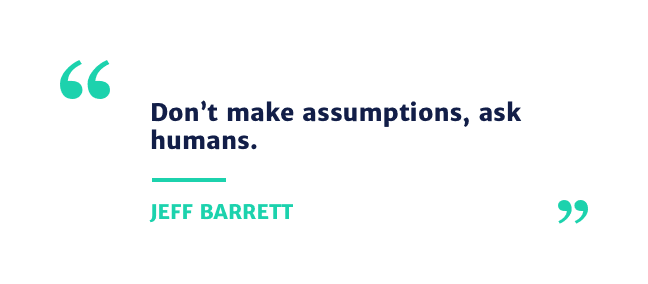Updated: January 24, 2024- 7 min read
This week Product School hosted Jeff Barrett, Product Manager at UserTesting for an #AskMeAnything session. Barrett discussed his approach to building a target audience and setting KPIs for new products. Barrett also tackled problem-solving when dealing with various types of products including cloud and a legacy CRM.

Meet Jeff Barrett
Jeff has been working in Product Management since 2014. He’s delivered products across several verticals all with a focus on Mobile and Emerging Tech. He has an absolute passion for learning and working on several side projects to help others grow in this space as well.
Currently, Jeff is working as a Product Manager at UserTesting, where he is responsible for the overall User Experience within the platform including a focus on the proprietary Design System, the Research Ops persona, and the Dashboard/Home Screen. Prior to working in product, Jeff served in Law Enforcement for the Department of Defense and Homeland Security.
“ What are the most important tools, methods or processes in your experience as a PM?”
Unequivocally, I believe Design Thinking is the most important of all. Being able to put who and why ahead of things like how and what defines problems much clearer and produce much more effective outcomes.
“Regarding target audience and KPIs for a new product: What would be your approach to narrow down on your target audience and also how about KPIs? Can you elaborate on using a banking or financial product?”
I believe defining new targets and KPIs should be through a hypothesis-driven approach. Meaning, until you aim for something and test against it, you are merely guessing. Use internal and external research to understand what problems others are solving and then ask people – are these the things that people want from us?
In banking, way too often I have seen innovation take precedence over problem-solving and an over-valuation on first to market. An example I had in my experience was trying to use AI/Voice Interactions in banking. New technology was out there and people assumed we needed to build for it. We did, we spent money, we launched, it tanked. Don’t make assumptions, ask humans.
“What suggestions would you give to Product Managers looking to grow in cloud and build SaaS products?”
New product delivery in SaaS is really fun and exciting. What I have learned is that if you build it but it can’t sell, it doesn’t matter. In SaaS, a PM serves two masters – the Sales team and the end-user. A good PM will listen to what people think they can offer to solve problems and then lean on their expertise and competitive analysis to ideate.
“What’re some quick ways to validate your hypothesis before approaching Engineering?”
I think it comes down to two things:
People are visual. Asking hypothetical questions on if this is something you would do without actually understanding what it means or having to do it, is useless. Think
storyboarding.
Accept that you will burn money learning, and this is a good thing. You will inevitably trash some work when you test and learn, know this going in and be okay with it.
“Right now I’m updating a legacy CRM and the company keeps wanting to add new features. At this point, we’re spending more time fixing bugs than iterating and scaling fast. The solution was to break out the company needs into microservices. Now that I have identified the services needed and the users per service, what tool do I use to collect user feedback? How do I prioritize those needs to decide which service to start an MVP for?”
This is less about CRM and much more about how to attack problem-solving. I call back to my reference to Design Thinking. Collecting user feedback can happen in a thousand ways. All the way from $250k tools to an Excel sheet – all of which work. The important step is understanding what that feedback can and cannot tell you. It is to be used as a guide and not a decision. I highly suggest taking on something like affinity clustering where you can identify patterns, then map those on a scale of effort/risk against value. You will see what problems overlap in some ways and I suggest starting there.

“As a PM, what comes next for you in terms of career progression? What do things look like for your mid-career? End-career?”
So I think that is different for different people and really depends on what interests you. I think the obvious progression is to move into some managerial role (Director of Product Management) where you are responsible for others and their career progression. Personally, I am not sure that is something that interests me.
I absolutely love mentoring and helping people grow in this space and pay forward what my mentors have for me. But I think I would more enjoy something similar to a Principal PM role where I can weigh in on greater scale problems at an org level, assist on the ground with work going on, and offer advice and direction without being a manager.
“What are your thoughts on setting expectations with executive stakeholders and timing of roadmaps?”
Being open with execs and stakeholders is much easier than people think. They are not interested in being a PM and almost 99% of the time, they are just hoping to market the work to another exec or a client. When things change or come up in a project, talk to the team and re-estimate when things look to be ready. Then talk to the exec and tell them what happened (which will likely lead to glossed over eyes), then tell them the next estimate. This will almost always lead to positive results and build trust.
“It seems to me that a lot of PM work can be consolidated into a cosourcing model where an external vendor can fulfill exactly the kind of vision you have in mind. Do you think PM is something that has to be internal or can you imagine outsourcing some of the functional obligations?”
So I will try to avoid bias here and sorry in advance if I don’t. The role of a PM when done correctly needs to be the most vocal, considerate, and aware individual in an organization. This means they should know who their user is better than anyone, what problems exist, and then the temperature of internal people (UX, engineering, sales, marketing, etc.). If this role can be contracted out to someone who serves part-time focusing on functional obligations, you are likely describing a different person.

“What business and specific technological skills should such a person work on?”
I think people get lost in what the term user is. Not always does this mean someone buying your widget online from their couch. Many times this equates to an internal customer who will need this data/technology to better serve their users (and so on and so on). Don’t treat any effort as a lift and shift.
Evaluate what problems exist for you and others today, and then consider how you can make those better. The example I can immediately think of with Azure is the handling of data limits. I am sure different teams consume different amounts at different times of the day and with different rates of performance. Those are your users – help them.
“Do you have any final advice for aspiring Product Managers?”
From an advice perspective, I want to make sure people understand what a Product Manager is and what it is not. Please understand the goal of this person is not to complete a project on time or within budget. In fact, many times this person needs to kill a project because it is no longer relevant.
Quoting a favorite movie of mine, “Embrace the Suck” because every day you will be required to tell someone no. Some days it’s your stakeholder, some days it’s your engineering team, some days it’s your user. The reason we exist is to make the best decision for all of those people and never forget why.
Did you miss this event? Check out our events page to sign up for the next #AskMeAnything session!
Updated: January 24, 2024




